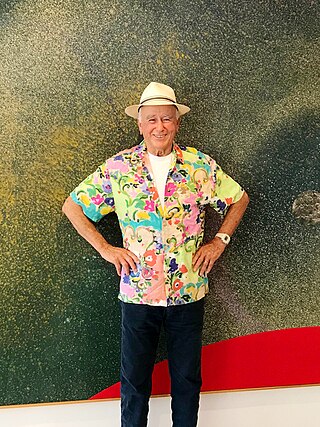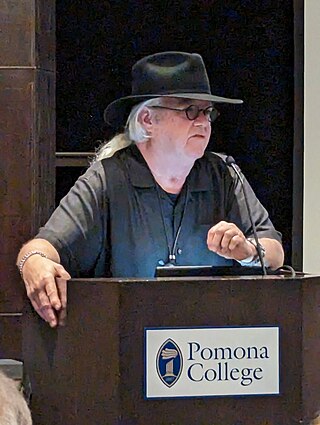Related Research Articles

Hard-edge painting is painting in which abrupt transitions are found between color areas. Color areas often consist of one unvarying color. The Hard-edge painting style is related to Geometric abstraction, Op Art, Post-painterly Abstraction, and Color Field painting.
Events from the year 1962 in art.

Jay DeFeo was a visual artist who became celebrated in the 1950s as part of the spirited community of Beat artists, musicians, and poets in San Francisco. Best known for her monumental work The Rose, DeFeo produced courageously experimental works throughout her career, exhibiting what art critic Kenneth Baker called “fearlessness.”

Edward Ralph Kienholz was an American installation artist and assemblage sculptor whose work was highly critical of aspects of modern life. From 1972 onwards, he assembled much of his artwork in close collaboration with his artistic partner and fifth wife, Nancy Reddin Kienholz. Throughout much of their career, the work of the Kienholzes was more appreciated in Europe than in their native United States, though American museums have featured their art more prominently since the 1990s.
Guy Bourdin, was a French artist and fashion photographer known for his highly stylized and provocative images. From 1955, Bourdin worked mostly with Vogue as well as other publications including Harper's Bazaar. He shot ad campaigns for Chanel, Charles Jourdan, Pentax and Bloomingdale's.
Judy Fiskin is an American artist working in photography and video, and a member of the art school faculty at California Institute of the Arts. Her videos have been screened in the Documentary Fortnight series at the Museum of Modern Art in New York, at the Los Angeles County Museum of Art, the Hammer Museum in Los Angeles, and at the J. Paul Getty Museum in Los Angeles; her photographs have been shown at MOCA, the Museum of Contemporary Art in Los Angeles, at the Getty Museum in Los Angeles, at The New Museum in New York City, and at the Pompidou Center in Paris.

Jim Newman is a film and television producer, contemporary art curator, gallerist and musician.
Walter "Chico" Hopps was an American museum director, gallerist, and curator of contemporary art. Hopps helped bring Los Angeles post-war artists to prominence during the 1960s, and later went on to redefine practices of curatorial installation internationally. He is known for contributing decisively to “the emergence of the museum as a place to show new art.”
The Ferus Gallery was a contemporary art gallery which operated from 1957 to 1966. In 1957, the gallery was located at 736-A North La Cienega Boulevard, Los Angeles in the U.S. state of California. In 1958, it was relocated across the street to 723 North La Cienega Boulevard where it remained until its closing in 1966.

Billy Al Bengston was an American visual artist and sculptor who lived and worked in Venice, California, and Honolulu, Hawaii. Bengston was probably best known for work he created that reflected California's "Kustom" car and motorcycle culture. He pioneered the use of sprayed layers of automobile lacquer in fine art and often used colors that were psychedelic and shapes that were mandala-like. ARTnews referred to Bengston as a "giant of Los Angeles's postwar art scene."

Peter Shelton is a contemporary American sculptor born in 1951 in Troy, Ohio.

Nancy Reddin Kienholz was an American mixed media artist based in Hope, Idaho. She worked in installation art, assemblage, photography, and lenticular printing. She was most famous for her collaborations with her husband and creative partner Edward Kienholz, from their meeting in 1972 until his sudden death in 1994. She continued to produce her own artworks for the rest of her life.
Craig Kauffman was an artist who has exhibited since 1951. Kauffman's primarily abstract paintings and wall relief sculptures are included in over 20 museum collections, including the Museum of Modern Art, the Whitney Museum of American Art, the Tate Modern, the Louisiana Museum of Modern Art, the Art Institute of Chicago, the Los Angeles County Museum of Art, Seattle Art Museum, and the Museum of Contemporary Art, Los Angeles.

Virginia Dwan was an American art collector, art patron, philanthropist, and founder of the Dwan Light Sanctuary in Montezuma, New Mexico. She was the former owner and executive director of Dwan Gallery, Los Angeles (1959–1967) and Dwan Gallery New York (1965–1971), a contemporary art gallery closely identified with the American movements of Minimalism, Conceptual Art, and Earthworks.

Kansuke Yamamoto was a photographer and poet. He was a prominent Japanese surrealist born in Nagoya, Japan.
Pacific Standard Time: Art in L.A., 1945–1980 was a scholarly initiative funded by the J. Paul Getty Trust to historicize the contributions to contemporary art history of artists, curators, critics, and others based in Los Angeles. Planned for nearly a decade, PST, as it was called, granted nearly 60 organizations throughout Southern California a total of $10 million to produce exhibitions that explored the years between 1945 and 1980. Underscoring the significance of this project, art critic Roberta Smith wrote in The New York Times:
Before [PST], we knew a lot [about the history of contemporary art], and that lot tended to greatly favor New York. A few Los Angeles artists were highly visible and unanimously revered, namely Ed Ruscha and other denizens of the Ferus Gallery, that supercool locus of the Los Angeles art scene in the 1960s, plus Bruce Nauman and Chris Burden, but that was about it. After, we know a whole lot more, and the balance is much more even. One of the many messages delivered by this profusion of what will eventually be nearly 70 museum exhibitions is that New York did not act alone in the postwar era. And neither did those fabulous Ferus boys.

George Herms is an American artist best known for creating assemblages out of discarded, often rusty, dirty or broken every-day objects, and juxtaposing those objects so as to infuse them with poetry, humor and meaning. He is also known for his works on paper, including works with ink, collage, drawing, paint and poetry. The prolific Herms has also created theater pieces, about which he has said, "I treat it as a Joseph Cornell box big enough that you can walk around in. It's just a continuation of my sculpture, one year at a time." Legendary curator Walter Hopps, who met Herms in 1956, "placed Herms on a dazzling continuum of assemblage artists that includes Pablo Picasso, Kurt Schwitters, Marcel Duchamp, and Joseph Cornell, as well as California luminaries Wallace Berman and Edward Kienholz." Often called a member of the West Coast Beat movement, Herms said that Wallace Berman taught him that "any object, even a mundane cast-off, could be of great interest if contextualized properly." "That’s my whole thing," Herms says. "I turn shit into gold. I just really want to see something I've never seen before." George Herms lives and works in Los Angeles.

Hassel Smith was an American painter.
Knud Merrild Nielsen was a Danish painter, sculptor and ceramicist.
Shirley Neilsen Blum, also known as Shirley Hopps is an American art historian, author, gallerist, and professor emeritus at the State University of New York, Purchase (1970–1989). She specializes in Northern Renaissance art, early Netherlandish art, and modern art. In the 1950s through the 1960s, she was active in the Los Angeles gallery scene, and she co-founded and co-ran Ferus Gallery.
References
- 1 2 3 Bradnock, Lucy (2012). "Walter Hopps's Los Angeles Pastoral". Art Journal. 71 (1): 126–137. doi:10.1080/00043249.2012.10791085. S2CID 190711064.
- ↑ Peabody, Rebecca et al. (eds) (2011). Pacific Standard Time: Los Angeles Art, 1945-80. Los Angeles: Getty. p. 75.
{{cite book}}:|first1=has generic name (help) - ↑ Ohio Department of Health. "Certificate of Death". Ohio Historical Society: state file no. 42714.
- ↑ "Blum, Shirley". Dictionary of Art Historians. Archived from the original on March 31, 2018. Retrieved March 30, 2018.
the couple (Hopps), along with the artist Edward Kienholz founded the Ferus Gallery in Los Angeles in 1957.
- ↑ Langsner, Jules (October 21, 1956). "Association Opens Show of 'Human Figure in Art'". Los Angeles Times . p. D6.
- ↑ Anon. (11 September 1955). "Art Events This Week". Los Angeles Times. p. D7.
- ↑ Getty Research Institute. "Syndell Studio" . Retrieved 1 July 2014.
- ↑ Flier for exhibition of work by Sonia Gechtoff, Syndell Studio, 1956. collection 2005.M.11: Los Angeles, Getty Research Institute.
{{cite book}}: CS1 maint: location (link) - ↑ Peabody (2011), pp. 63-68.
- ↑ Allan, Ken (2002). "Creating an avant-garde in 1950s Los Angeles: Robert Alexander's hand-printed gallery brochure in the Archives of American Art". Archives of American Art Journal. 42 (3–4): 21–26. doi:10.1086/aaa.42.3_4.1557788. S2CID 193341114.